| On October 20 the 142nd Infantry, by extending its
already widely dispersed battalions, began relieving the 141st from the sector
south of Herpelmont. After only sufficient time for badly needed showers, the Alamo
regiment, moving by night, was assembled near Belmont by the 23rd and started
reconnaissance for the attack. Except for terrain the task did not appear to be too
difficult. The ridge over which the attack was to go was some seven kilometers long but
only about two-and-one-half wide. More than a thousand feet above the valley floor, its
steep sides were cut by numerous deep gullies. The entire ridge was heavily wooded and
badly overgrown. No roads of any kind existed, only one trail. Movement then would
have to be in a column of files. The ridge pointed directly into the German position. When
it had been taken the 36th would surround on three sides the German Corps mountain
position east of the Valogne River. The
order to launch the attack came late on October 23. Early next morning the 1st Battalion,
141st, started its trek up the mountain. The 3rd Battalion moved on another trail to the
north to protect the left flank. The attack went well, German opposition was quickly
overcome and by late afternoon the head of the column had gone seven kilometers and
reached its objective.
Then came the counterattack. Striking from both
sides the Germans succeeded in severing the thin column. Companies A and B, a part of
Company C and a platoon of Company D were cut off from the Battalion Commander and the
remainder of the battalion. The only communication existing between the forward part of
the battalion and Regiment was through the radio of 1st Lieutenant Erwin Blonder, Forward
Observer of the 131st Field Artillery, with Company A.
The 2nd Battalion was brought up that night and
launched against the hostile positions on the left of the trail but found itself blocked
by superior forces east of Biffontaine. For two days and nights the regiment fought
desperately to push its way through, but the enemy, aided by the rough terrain, held the
men off. The defense had every advantage: German artillery pounded the ridge unceasingly
with devastating effect on the attackers. In covered foxholes themselves, the enemy
suffered little from our artillery, the delivery of which was exceedingly difficult
because of the denseness of the forest. On October 25 the 2nd Battalion of the 442nd,
which had come out of the line only the day before, was committed to protect the left
flank and to permit the 3rd Battalion, 141st, to move over toward the "lost"
battalion. On October 26 the remainder of the Nisei regiment was committed to force a
passage down the main trail while the 2nd Battalion, 141st, kept pushing to the right.
Meanwhile the beleaguered force held on. It was
completely surrounded and heavily bombarded by the enemy artillery. Of a combat patrol of
forty men sent out to get through to our line, only five returned. Lt. Blonder, to
conserve his radio batteries, communicated with Regiment only twice a day. For three more
long days, the 100th and 3rd Battalions, 442nd, struggled along the trail. The Germans had
to be dug out by bayonet.
The crisis came late on the 29th when a furious
counter-attack was beaten off by the 3rd Battalion, 442nd. Early next day the Nisei
broke through. The 211 surviving brave men, who had withstood a seven-day siege without
food or water and with little ammunition, had been rescued by their courageous comrades of
the 442nd, whose companies in many cases had shrunk to 40 or 50 men. No greater example of
fortitude and courage was shown in this war.
|
|
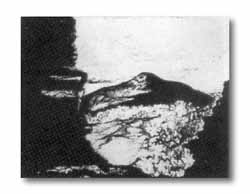
| The Battalion took its objective and moved past the elbow of
the hill. |
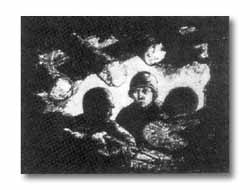
| Discovering that they were cut off, three officers conferred. |
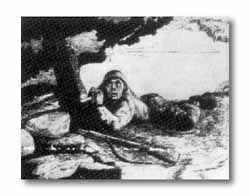
| Knives were used to fell trees because axes brought German
bullets. |
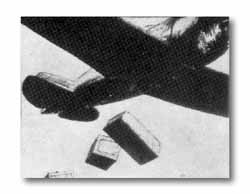
| P-47's dive-bombed the battalion with food, water and medicine. |
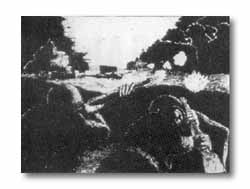
| The Germans watched and picked-up the supplies first. |

| The 141st fought to recover the food. |
|